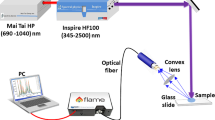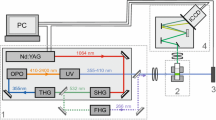Abstract
Laser-induced fluorescence technique (LIF) is described for getting bacteria spectra in the liquid phase. An excimer laser pumping a dye-laser and a doubly frequency laser have been used, exciting the bacteria to 290 nm, and using a monochromator, 600 lines/mm grating, with a CCD to measure and obtain the fluorescence spectra. In this study, a laser induced fluorescence system to measure certain bioaerosols (bacteria) was optimised. Finally, a small bacteria fluorescence spectra collection is presented.










Similar content being viewed by others
References
Hinds WC (1999) Aerosol technology: Properties, behavior, and measurement of airborne particles, 2nd edn. John Willey & Sons
Parat S, Perdrix A, Baconnier P (1999) Relationships between air-conditioning, airbone microorganisms and health. Bull Acad Nat Med 183(2):327–344
Spurny KR (1994) On the chemical detection of bioaerosols. J Aerosol Sci 25(8):1533–1547
Ge Z, Wexler AS, Johnston MV (1998) Laser desorption/ionization of single ultrafine multicomponent aerosols. Environ Sci Technol 32:3218–3223
Jayne JT, Leard DC, Zhang X, Davidovits P, Smith KA, Kolb CE, Worsnop DR (2000) Development of an aerosol mass spectrometer for size and composition analysis of submicron particles. Aerosol Sci Technol 33(1–2):49–70
Cheng YS, Barr EB, Fan BJ, Hargis PJ Jr, Arder DJ, O’Hern TJ, Torczynski JR, Tisone GC, Preppernau BL, Young SA, Radloff RJ (1999) Detection of bioaerosols using multiwavelength UV fluorescence spectroscopy. Aerosol Sci Tech 30:186–201
Pan YI, Holler S, Chang RK, Hill SC, Pinnick RG, Niles S, Bottiger JR (1999) Single-shot fluorescence spectra of individual micrometer-sized bioaerosols iluminated by a 351- or a 266-nm ultraviolet laser. Opt Lett 24(2):116–118
Seaver M, Eversole JD, Hardgrove JJ, Cary WK Jr, Roselle DC (1999) Size and fluorescence measurements for field detection of biological aerosols. Aerosol Sci Tech 30(2):174–185
Acknowledgments
Government of Spain, Ministerio de Educación y Ciencia (project REN2002-01439/CLI), University of La Rioja (projects API-02/07, API-03/07, API-04/05), Government of La Rioja (project ANGI 2001/36). Thanks to Dra. Carmen Torres research group from the University of La Rioja and Dr. Rafael Pereira from Innova Instrumentación S.L. This work has not been posible without the advices and the collaboration of Professors Jim Winefordner, Ben Smith and Nico Omenetto from the University of Florida (Gainesville, FL, USA).
Author information
Authors and Affiliations
Corresponding author
Rights and permissions
About this article
Cite this article
Cabredo, S., Parra, A. & Anzano, J. Bacteria Spectra Obtained by Laser Induced Fluorescence. J Fluoresc 17, 171–180 (2007). https://doi.org/10.1007/s10895-007-0155-7
Received:
Accepted:
Published:
Issue Date:
DOI: https://doi.org/10.1007/s10895-007-0155-7




